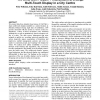Free Online Productivity Tools
i2Speak
i2Symbol
i2OCR
iTex2Img
iWeb2Print
iWeb2Shot
i2Type
iPdf2Split
iPdf2Merge
i2Bopomofo
i2Arabic
i2Style
i2Image
i2PDF
iLatex2Rtf
Sci2ools
CHI
2008
ACM
2008
ACM
It's Mine, Don't Touch!: interactions at a large multi-touch display in a city centre
We present data from detailed observations of CityWall, a large multi-touch display installed in a central location in Helsinki, Finland. During eight days of installation, 1199 persons interacted with the system in various social configurations. Videos of these encounters were examined qualitatively as well as quantitatively based on human coding of events. The data convey phenomena that arise uniquely in public use: crowding, massively parallel interaction, teamwork, games, negotiations of transitions and handovers, conflict management, gestures and overt remarks to co-present people, and "marking" the display for others. We analyze how public availability is achieved through social learning and negotiation, why interaction becomes performative and, finally, how the display restructures the public space. The multi-touch feature, gesturebased interaction, and the physical display size contributed differentially to these uses. Our findings on the social organization of the u...
CHI 2008 | Human Computer Interaction | Large Multi-touch Display | Physical Display Size | Public Displays |
| Added | 30 Nov 2009 |
| Updated | 30 Nov 2009 |
| Type | Conference |
| Year | 2008 |
| Where | CHI |
| Authors | Peter Peltonen, Esko Kurvinen, Antti Salovaara, Giulio Jacucci, Tommi Ilmonen, John Evans, Antti Oulasvirta, Petri Saarikko |
Comments (0)

